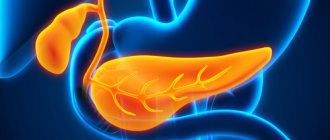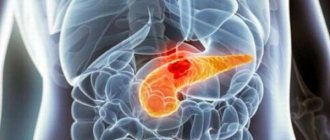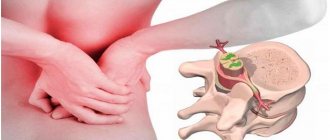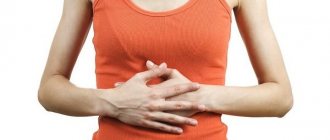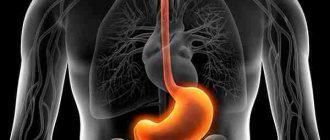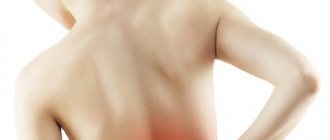Diseases that cause discomfort in the pancreas
Painful sensations in the pancreas can be caused by:
- acute pancreatitis. This is an inflammatory process that occurs due to the fact that stagnant enzymes dissolve surrounding tissues; if an infection occurs, an acute form may develop;
- chronic pancreatitis. It forms after an attack of acute pancreatitis or diseases of the liver, thyroid gland, etc.;
- pancreatic necrosis. With this disease, organ tissue becomes dead;
- cholecystopancreatitis. A pathology in which a failure in the synthesis of bile begins and the process of digestion of fats and carbohydrates is disrupted.
Video on the topic:
Pain in the pancreas can occur due to tumors of various etiologies, cysts, fistulas, and stones.
Pain in the pancreas can also occur with:
- biliary dyskinesia;
- stomach and duodenal ulcers;
- intestinal infection;
- diabetes mellitus;
- duodenitis;
- injuries to the abdominal area and internal organs;
- misuse or overuse of medications;
- viral hepatitis of all forms;
- constant stress,
- vegetative-vascular dystonia;
- alcohol abuse and smoking;
- genetic predisposition.
Why does the pancreas hurt?
When the stomach hurts on the left side, most often it signals a disorder of the pancreas. Its work is influenced by a lot of factors, both from the internal and external world.
Key causes of pain in the pancreas:
- Poor nutrition. It consists of eating too much junk food, for example, fatty, spicy foods, smoked foods, canned food and others. In addition, you should not eat at night, which disrupts hormonal regulation.
- Alcohol and nicotine consumption. A large amount of such substances causes excessive production of pancreatic juice, which in excess begins to destroy cells from the inside.
- Metabolic dysfunction often manifests itself in the form of obesity.
- Very often, the functioning of the pancreas is influenced by organs of other systems, therefore, when they are dysfunctional, changes in the functioning of the pancreas are observed. This includes the digestive organs, gall bladder with ducts and liver.
- Diseases of the circulatory system that cause insufficient blood supply to the organ.
- Long-term use of medications, in particular antibiotics, sedatives and hormonal drugs.
- Inflammatory and infectious foci in the human body.
- Age factor. It is explained by the fact that processes in the gland take place constantly and with age the organ wears out, which is why the level of its functioning decreases.
- Infection of the body with parasites. Typically, helminths live in the intestines, but in the case of an active stage of infection they can penetrate other organs, for example, the pancreas.
- Injuries to an organ in which cells are damaged or formations appear in the form of hematomas and abscesses.
These are the main reasons that can cause pain in the pancreas area. However, the symptoms are very similar to other diseases of the internal organs, so treatment is prescribed exclusively by a doctor. What to do if characteristic signs appear?
Types of pain in the pancreas and diseases associated with it
The nature of the pain depends on the causes of its occurrence:
- Pain in the right hypochondrium indicates problems with the liver.
- Girdle pain, in which acute attacks can radiate to the back or shoulder blade, is inflammation of the gallbladder.
- The pain starts from the solar plexus and goes to the back, sharp pain under the right or left hypochondrium are signs of pancreatic inflammation. This pain increases when lying down (usually at night).
- Cutting pain in the upper left abdomen and solar plexus with blue discoloration around the navel indicates damage to the spleen.
- Attacks of stabbing and cutting pain throughout the abdomen, indigestion (diarrhea or colitis), drops of blood in the stool - disruption of intestinal function.
- Aching pain in the left abdominal region and bouts of vomiting - gastric syndrome.
- Acute pain in the lower abdomen, radiating to the navel - appendicitis.
Locations of pain and accompanying symptoms of diseases
When a person stands upright, the pancreas is located at the level of the 1st lumbar vertebra. The pancreas itself consists of three sections: “body”, “head” and “tail”. The “body” is located behind the stomach, the “head” is near the duodenum, and the “tail” is near the spleen. Pain may be felt in the hypochondrium area or localized to the right under the scapula; it may be felt in the upper abdomen, intensify and spread throughout the abdomen. This location of pain indicates inflammation of the pancreatic tissue or pancreatitis.
Other symptoms of pancreatitis include:
- prolonged constipation;
- bloating and heaviness of the abdomen;
- bad breath;
- as the disease develops, it may begin to hurt in the right side (in the place where the pancreas is located). The pain becomes so severe that the person is unable to move or even turn, and the side reacts even to touch;
- then the temperature rises significantly;
- apathy and weakness begin;
- nausea and vomiting appear, some suffer from diarrhea;
- pulse quickens;
- the sclera of the eyes turns yellow.
With acute or chronic pancreatitis, the symptoms are different.
In the chronic course of the disease, the following symptoms may appear:
- when the head of the gland is inflamed, pain is felt in the epigastric region and right hypochondrium;
- when the source of inflammation is located in the “tail”, pain is felt in the left hypochondrium;
- when the entire pancreatic organ is affected, the pain is girdling in nature, radiating to the back and left shoulder blade;
- There may be shooting pain in the tailbone, groin, which radiates to the thigh.
Diagnosis of the disease
To find out the causes of pain in the pancreas, the following methods are used:
- palpation. It is used during the initial examination of the patient to preliminary determine the causes of pain. A cyst or tumor may be detected;
- probe examination. Prescribed for suspected pancreatitis;
- urine and stool tests;
- Ultrasound. Helps diagnose the presence of cysts and tumors;
- MRI. With its help, you can examine the pancreas more thoroughly;
- X-ray. With its help, you can recognize the expansion or narrowing of the excretory duct.
Enzyme products
What medications should I take when there is pain in the pancreas? To do this, in order to relieve the symptoms of pain, it is recommended to take medications containing enzymes. In terms of their components, they are identical and differ only in the concentration of enzyme composition per mg of weight. All have an identical structure and composition with the secreted substances of the pancreas. Thanks to this, they do not cause side effects to the body, as they are well absorbed and participate in the breakdown of food.
These medications are taken with meals or 15 minutes before eating. It is forbidden to chew or break tablets with enzymes, as in this case the enzyme components will not reach the intestines and duodenum. Before use, undergo diagnostic procedures and prescribe the tablets needed at this stage of development of pancreatitis. Only then will the doctor select the necessary drugs and quantitative composition for the pathology in an individual form. What is the best medicine for pancreatic pain?
To help the body and the pancreas, there are some groups of drugs that contain the necessary amount of enzymes for various forms of progression of inflammation of the pancreas:
- Combined preparations containing pancreatic and bile enzymes:
- Bobenzyme;
- Kpeon;
- Festal;
- Gastal;
- Enzistal;
- Digestal;
- Comilaza.
- Contains pancreatin:
- Pancreatin;
- Pancreazim;
- Mezim.
- With plant substances:
- Biozyme;
- Nigedase.
Pancreatin and Creon
The doctor will decide which pill to take for pain in the pancreas, according to the course of the disease.
Treatment of causes of pain in the pancreas
Therapy is prescribed depending on the disease that caused pain in the pancreas. There are several treatment methods: medication, surgery, folk remedies, diet.
If the cause of pain in the pancreas is acute pancreatitis, then treatment is carried out in a hospital setting. The purpose of the treatment is:
- elimination of pain in the pancreas;
- restoration of pancreas functionality;
- preventing complications.
To relieve pain in the pancreas, painkillers are taken - they help reduce swelling of the pancreas and have an analgesic effect. If the medicine does not have an analgesic effect for a long time, then it is recommended to take a knee-elbow position to relieve the pressure of the unhealthy organ on the central abdominal node - this helps reduce pain. To reduce the functionality of the organ, you can put ice on your stomach and side.
How to relieve pain, what pill should you take to relieve it in the pancreas?
Antispasmodics help relieve pancreatic pain:
- "Drotaverine". This is a vasodilator that acts on smooth muscle tissue, it relieves spasms that cause pain. This drug dilates blood vessels and promotes oxygen enrichment at the cellular level.
- “No-spa” is used for various diseases: pathologies of the gastrointestinal tract, kidneys, bladder, cholelithiasis.
- “Papaverine” quickly relieves spasms; it is injected into the rectum, from where it quickly spreads through the tissues.
In addition to antispasmodics, drugs with a different spectrum of action are prescribed:
| Drug name | Impact spectrum |
| Metoclopramide | Stimulates peristalsis of the upper gastrointestinal tract, reduces nausea, hiccups, and has an antiemetic effect. |
| Abaktal, Vancomycin, Ceftriaxone (antibiotics) | Prevent complications (peritonitis, sepsis, abscess) and destroy bacteria. |
| Omeprazole | Reduces acid levels, quick pain reliever |
| Hilak Forte, Smecta | Helps with diarrhea |
| Enterosgel | Used for symptoms of poisoning |
When diagnosing pancreatitis, enzymes must be prescribed to normalize digestion. They supply the body with substances necessary to normalize the processes of absorption and assimilation. The active substance in enzymes is pancreatin. Such drugs include: “Festal”, “Creon”, “Mezim”, “Pankreon” and others.
If the resulting pathology is accompanied by external secretory insufficiency and dyspepsia, then antacids are prescribed that suppress the production of hydrochloric acid. Such drugs are: “Maalox”, “Almagel”, “Phosphalugel”.
Prokinetics (drugs that improve the functioning of the gastrointestinal tract) are prescribed - "Metoproclamide", "Gastroscan", gastroprotectors (drugs that have a positive effect on the condition of the gastric mucosa, protecting it from various negative factors) - "Sucralfate", "Rebamipid", "Espumizan", "Meteospasmil."
If the disease causes an abscess, peritonitis, or a malignant tumor, then surgical intervention (pancreatectomy) is prescribed. Resection of the affected area and removal of the abscess are performed. Complete excision of the organ is done only in the most severe cases, when other measures are powerless.
Treatment of the pancreas at home
As additional methods of treatment, you can use time-tested folk remedies. They are quite effective, but only in treating mild forms of the disease.
Oatmeal broth
Oats are pre-soaked in warm water for a day. Then it is dried and crushed using a blender. 1 teaspoon of oats is poured into 200 ml of clean water and cooked for 30 minutes over low heat (do not bring to a boil). The prepared decoction is drunk all at once. The next day you need to prepare a fresh portion. The duration of the treatment course is 2-3 days.
Flax jelly
This remedy relieves inflammation and relieves pain in the pancreas. To prepare, add 1 tablespoon of flax seeds to 400 ml of water and cook for 8-10 minutes over low heat. Then leave for 1-2 hours. The product is filtered through cheesecloth and drunk warm throughout the day.
Potato juice
Squeeze juice from 2 large potatoes. You should take 50 ml of juice before meals. To increase the healing properties after potato juice, you should immediately drink 200 ml of kefir.
Propolis tincture
Tincture with propolis helps cope with gastrointestinal pathologies. To do this, 2 tablespoons of propolis are poured into 100 ml of boiled water and infused for 24 hours. You should take 1 tablespoon of the tincture three times a day.
Herbal collection
In order to cope with the pain that arises, you can prepare a decoction from a collection of medicinal plants: marsh cucumber, medicinal marigold, yarrow and peppermint. All herbs are taken in equal proportions. 2 tablespoons of the mixture are poured into 200 ml of boiling water and left for 40 minutes. Then the infusion is filtered and drunk twice a day, 100 ml.
Wormwood tincture
With regular use of this tincture, pain in the pancreas is reduced, it helps with liver diseases and gastritis. To prepare the tincture, you need to fill a liter or 2 liter jar with wormwood flowers, pour vodka over it and leave in a dark place for 1 week. After infusion, strain the product and take 1 teaspoon every morning on an empty stomach. A few minutes after taking the product, you should eat the same amount of honey. The duration of the treatment course is 10 days, then a 30-day break. Take the tincture until it runs out.
First aid for pain in the pancreas
First aid for pain in the pancreas at home is to take the fetal position and slightly tilt the body forward. This position slightly relieves the pain, which allows you to wait for the ambulance to arrive.
For pain in the pancreas, regardless of the treatment method used, it is recommended to drink 30 ml of still mineral water every 15-20 minutes. This helps enhance the effect of the medications or folk remedies used.
Chicory is used as a choleretic remedy for pain in the pancreas - 5 g of chicory powder is poured into 200 ml of boiling water. You should drink this remedy in small portions 20 minutes before meals.
Mumiyo is used for various diseases. The drug is used both in the form of tablets and in the form of an extract.
If pain occurs in the pancreas, the use of warm compresses is not allowed; on the contrary, cold lotions are needed at the site of the source of pain and complete rest for the patient.
The use of traditional methods of treatment is possible with the permission of a doctor and when treating a child.
How to relieve an acute attack
When the pancreas hurts very badly, medical attention is needed. Self-medication in such cases can lead to dire consequences. After all, pain can be caused by blockage of the ducts, tumor growth or tissue necrosis. If treated improperly, these processes progress rapidly, and an abscess, blood poisoning, or peritonitis may form. Even a normal exacerbation of chronic pancreatitis is also dangerous. Even though patients usually know how to relieve pain, it is still recommended to consult a doctor. After all, each attack increases the risk of developing necrotic processes and fibrous tissue degeneration.
Therefore, if acute girdling pain, nausea, weakness and upset bowel movements occur, you should immediately call an ambulance. But you still need to know how to relieve pain in the pancreas, because it may take some time before the doctor arrives.
To relieve an acute attack, it is recommended to apply a heating pad with ice to the stomach.
First of all, you must immediately stop eating any food. It is advisable to fast for 2-3 days; during this time you are allowed to drink only still mineral water or rosehip decoction. This provides rest to the diseased organ and speeds up its recovery. A heating pad with ice placed on the pancreatic area also helps reduce pain. Sometimes the patient is recommended to stand on all fours - in this position the pressure on the nerve plexus is reduced. But in any case, you need to move as little as possible.
Self-administration of painkillers is not recommended. After all, during an acute attack, taking pills is contraindicated. All medications are administered to the patient intramuscularly or intravenously.
Most often, Analgin, Paracetamol, No-Shpa or Papaverine are prescribed for this. But when they are ineffective, narcotic analgesics are used, for example, Tramadol.
Yoga for pain in the pancreas
Many diseases are caused by abnormal changes in smooth muscle tone. These processes cannot be controlled, but by mastering several asanas that can be performed at home, you can prevent the development of complications.
Pavanmuktasana has a beneficial effect on the functioning of all internal organs and activates the functioning of the pancreas. To do this, you need to stand up straight, lower your arms, raise your right leg bent at the knee and press it to your chest. Place your left hand on your knee and grab your ankle with your right hand. Stand like this for 6 seconds, then return to the starting position. Do the same on the other leg. Perform this exercise 6 times daily.
Paschimottanasana stimulates the functioning of internal organs and has a beneficial effect on the gastrointestinal tract. You need to sit down with your legs stretched forward, lean forward and down, and reach your ankles with your hands, your head should rest on your knees, after 6 seconds we return to the starting position. Do it 3 times.
Diet for pain in the pancreas
By following a special diet in combination with drug therapy, various diseases of the pancreas can be cured.
At the time of exacerbation of pancreatitis and the next 3 days, a complete refusal to eat is recommended. You can drink liquids (still mineral water, weak tea, herbal decoctions). The liquid consumed will remove most of the harmful substances from the body. After a few days of therapeutic fasting, when all pain syndromes are relieved, you can eat simple and light food: oatmeal, jelly, boiled or baked vegetables, lean meat and fish.
Table of permitted and prohibited foods during the diet:
| Prohibited for use | You can eat |
| Alcohol | Eggs |
| Canned foods | Dairy |
| Fruit juices (due to high sugar content) | Some types of berries (currants, plums, cherries, blueberries), pomegranate |
| Fatty meats and fatty fish | Lean meat and lean fish |
| Smoked, fried, spicy food | Vegetable soups, puree soups |
| Chocolate and other sweets | Porridge (preferably oatmeal) |
| Chips, croutons | Yeast-free bread |
| Mushrooms | Vegetable stew |
Video on the topic:
It is important to follow the following rules of proper nutrition: eat 5-6 small meals a day, avoid drinking alcoholic and carbonated drinks, etc.
Symptoms of other pancreatic diseases
In addition to acute pancreatitis, there are other diseases that affect the pancreas. In these cases, the symptoms depend on the stage of development of the pathology.
Most diseases of the pancreas have characteristic symptoms - pain, dyspepsia . Features are manifested in specific signs and diagnostics.
Pain
- Pancreas cancer. The nature of the pain can be either episodic or constant. Depends on the location of the tumor and the stage of the disease.
- Cystic fibrosis. There are painful contractions throughout the intestines .
- Pancreatic cyst. With small cysts, the pain is dull and intermittent, weakly expressed or not felt at all. Pronounced pain arises from a cyst of considerable size, which compresses the ducts, nerve trunks and stretches the capsules of the organ. If the head is affected, there is pain in the right part of the epigastrium; if processes occur in the tail part, there is pain in the left part.
- Chronic pancreatitis. If the process is not aggravated, then the pain syndrome does not appear. During an exacerbation, a sharp or dull pain is felt in the epigastric region with expansion into the lumbar region. Or there are girdling pains of varying degrees of intensity.
- With type 1 diabetes there is no pain.
- Pancreatic necrosis. Severe, pronounced acute pain in the epigastrium or behind the sternum, radiating to the collarbone or back. The peak of pain can cause shock, which in turn can lead to loss of consciousness.
Dyspeptic symptoms
- Pancreas cancer. , nausea, unstable fatty stools and decreased appetite occur occasionally There are losses in body weight. The abdomen is characteristically distended. The late stage of the disease is accompanied by frequent vomiting and profuse diarrhea.
- Cystic fibrosis. The presence of frequent fatty stools with volumes several times higher than normal. Decreased appetite, flatulence.
- Pancreatic cyst. The abdomen is bloated, thinness and frequent stools occur when the head of the organ is affected. Pathology of the body and tail is expressed by discolored stool, constipation, and occasional attacks of nausea.
- Chronic pancreatitis. The stool is unstable - constipation is replaced by diarrhea. If the diet is violated, frequent fatty stools occur. Constant nausea, vomiting either food or bile.
- Diabetes mellitus type 1. Weight has been greatly reduced . Weakness and feeling of hunger in a hypoglycemic state. If a patient has ketoacidosis, the condition is characterized by nausea and vomiting.
- Pancreatic necrosis. The abdomen is distended, stool retention.
Specific signs
- Pancreas cancer. Jaundice, pallor. The late stage is expressed by extreme exhaustion of the body.
- Cystic fibrosis. Salt crystals are deposited on the skin, weakness, dry mouth.
- Pancreatic cyst. Large formations can be felt through the abdominal wall. Suppuration of the cyst is characterized by abdominal pain and high fever.
- Chronic pancreatitis. Consumption of marinades, as well as fatty, smoked and fried foods provokes an exacerbation.
- Diabetes mellitus type 1. The volume of urine produced increases, thirst, itching of the mucous membranes and skin. Hypoglycemia and ketoacidosis.
- Pancreatic necrosis. Acute abdominal pain, there is a high probability of painful or toxic shock.
Laboratory data and diagnostics
- Pancreas cancer. The erythrocyte sedimentation rate is accelerated - more than 30 mm/hour. Anemia and leukocytosis . Ultrasound reveals a rounded formation. The diagnosis is confirmed based on the results of the biopsy.
- Cystic fibrosis. Fecal elastase levels are low. High chloride sweat test. DNA diagnostics.
- Pancreatic cyst. The level of enzymes in urine and blood is slightly increased. Ultrasound reveals a fluid formation.
- Chronic pancreatitis. In the acute phase, blood elastase increases. Reduced fecal elastase .
- Diabetes mellitus type 1. Blood sugar exceeds 6.1 mmol/l. Glycemic hemoglobin level > 6.5%.
- Pancreatic necrosis. Ultrasound reveals destruction of the pancreas.
Disease prevention
The following preventive measures exist:
- eat properly and healthy food;
- exercise;
- reduce the amount of alcohol consumed;
- no smoking;
- Consult your doctor about the medications you are taking, as some of them may cause pancreatitis.
List of references: https://aif.ru/boostbook/boli-v-podzheludochnoi-zheleze.html https://www.alfazdrav.ru/zabolevania/zabolevaniya-podzheluzhochnoy-zhelezy/pankreatit/ https://www.kp. ru/guide/zabolevanija-podzheludochnoi-zhelezy.html santalen.com.ua/bolit-podzheludochnaya-zheleza-simptomy-i-lechenie/ https://astery-med.ru/whatailsyou/pishevarenie/zab_podjel_jelezy.php med.vesti. ru/articles/zabolevaniya/simptomy-zabolevanij-podzheludochnoj-zhelezy/ https://www.gmsclinic.ru/gms/press/articles/art-pancreatitis https://zdravcity.ru/blog-o-zdorovie/podzheludochnaya-zheleza -simptomy-bolezney/ https://ngradlpu.ru/stati/2017-god/412-podzheludochnaya-zheleza-lyubit-golod-i-kholod.html https://yandex.ru/health/turbo/articles?id= 4475 https://yandex.ru/health/turbo/articles?id=4458 Notes from the author of the article, based on personal experience. This material is purely subjective and is not a guide to action. Only a qualified specialist can determine an accurate diagnosis and prescribe treatment.
Last modified: 03/11/2020
